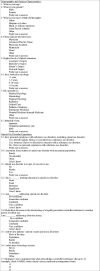Opioid Risk Mitigation Practices of Interprofessional Oncology Personnel: Results From a Cross-Sectional Survey
- PMID: 37498515
- PMCID: PMC10628582
- DOI: 10.1093/oncolo/oyad214
Opioid Risk Mitigation Practices of Interprofessional Oncology Personnel: Results From a Cross-Sectional Survey
Abstract
Background: This study explored the risk mitigation practices of multidisciplinary oncology health-care personnel for the nonmedical use of opioids in people with cancer.
Methods: An anonymous, cross-sectional descriptive survey was administered via email to eligible providers over 4 weeks at The Ohio State University's Arthur G. James Cancer Hospital. The survey asked about experiences and knowledge related to opioid use disorders.
Results: The final sample of 773 participants included 42 physicians, 213 advanced practice providers (APPs consisted of advanced practice nurses, physician assistants, and pharmacists), and 518 registered nurses. Approximately 40% of participants responded feeling "not confident" in addressing medication diversion. The most frequent risk reduction measure was "Checking the prescription drug monitoring program" when prescribing controlled medications, reported by physicians (n = 29, 78.4%) and APPs (n = 164, 88.6%).
Conclusion: People with cancer are not exempt from the opioid epidemic and may be at risk for nonmedical opioid use (NMOU) and substance use disorders. Implementing risk reduction strategies with every patient, with a harm reduction versus abstinence focus, minimizes harmful consequences and improves. This study highlights risk mitigation approaches for NMOU, representing an opportunity to improve awareness among oncology health-care providers. Multidisciplinary oncology teams are ideally positioned to navigate patients through complex oncology and health-care journeys.
Keywords: harm reduction; nonmedical use of opioids; oncology health-care personnel; opioid use disorders.
© The Author(s) 2023. Published by Oxford University Press.
Conflict of interest statement
The authors indicated no financial relationships.
Figures
Similar articles
-
Presence of opioid safety initiatives, prescribing patterns for opioid and naloxone, and perceived barriers to prescribing naloxone: Cross-sectional survey results based on practice type, scope, and location.J Opioid Manag. 2021 Jan-Feb;17(1):19-38. doi: 10.5055/jom.2021.0611. J Opioid Manag. 2021. PMID: 33735425
-
Interprofessional Oncology Providers' Experiences and Knowledge of Opioid Use Disorders in Patients With Cancer.Oncol Nurs Forum. 2022 May 1;49(3):213-221. doi: 10.1188/22.ONF.213-221. Oncol Nurs Forum. 2022. PMID: 35446835
-
Best Practices in the Management of Nonmedical Opioid Use in Patients with Cancer-Related Pain.Oncologist. 2020 Mar;25(3):189-196. doi: 10.1634/theoncologist.2019-0540. Epub 2019 Dec 24. Oncologist. 2020. PMID: 31872911 Free PMC article. Review.
-
Survey of Ontario primary care physicians' experiences with opioid prescribing.Can Fam Physician. 2011 Mar;57(3):324-32. Can Fam Physician. 2011. PMID: 21402971 Free PMC article.
-
A Systematic Review of Interventions and Programs Targeting Appropriate Prescribing of Opioids.Pain Physician. 2019 May;22(3):229-240. Pain Physician. 2019. PMID: 31151331
Cited by
-
Opioid use in cancer patients compared with noncancer pain patients in a veteran population.JNCI Cancer Spectr. 2024 Feb 29;8(2):pkae012. doi: 10.1093/jncics/pkae012. JNCI Cancer Spectr. 2024. PMID: 38457606 Free PMC article.
References
MeSH terms
Substances
Grants and funding
LinkOut - more resources
Full Text Sources
Medical


